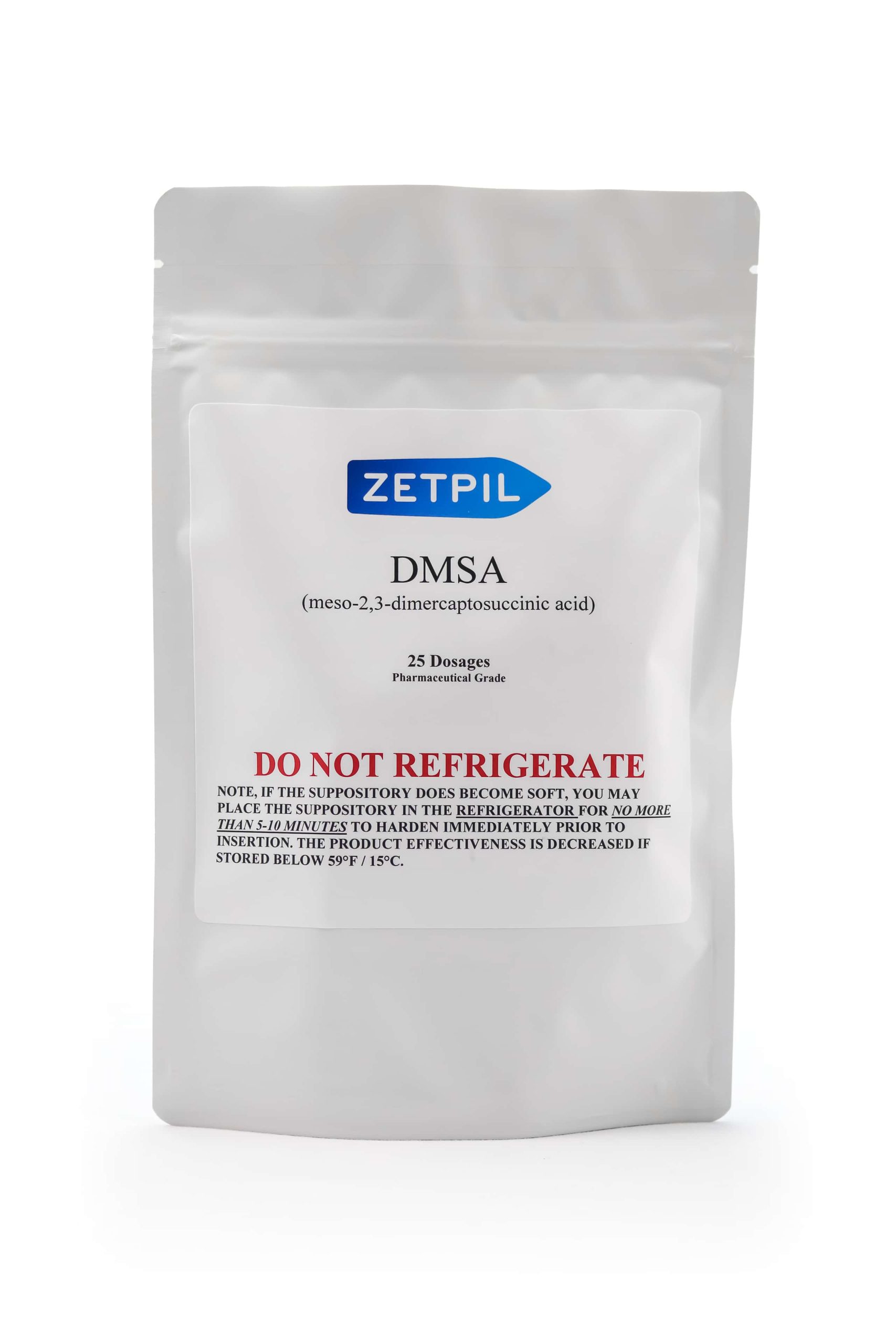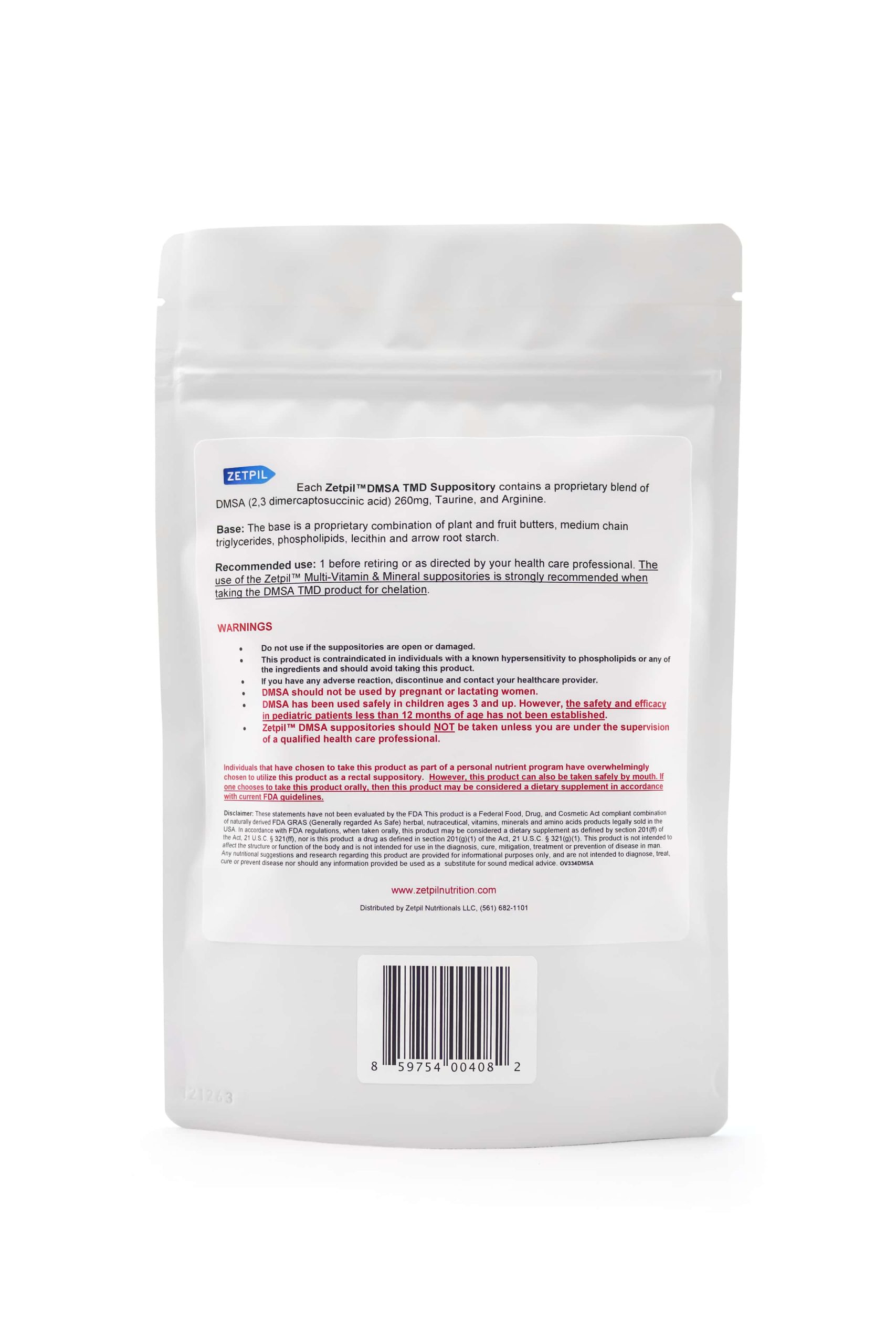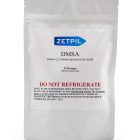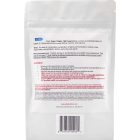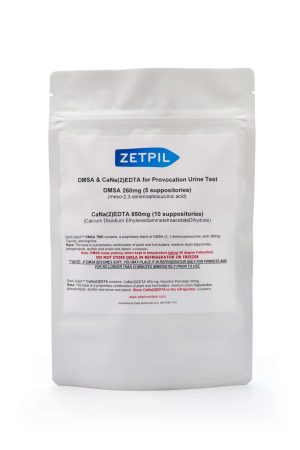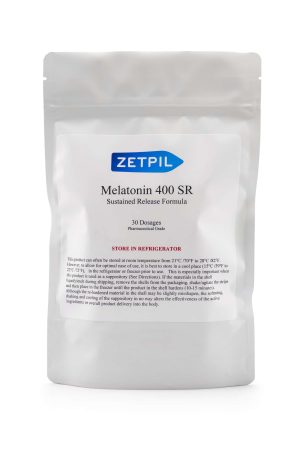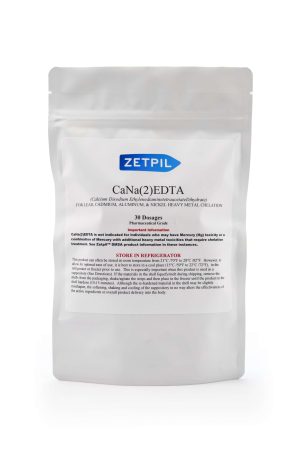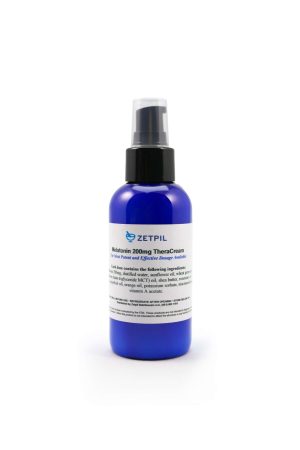Description
Zetpil™ Suppository Advantage
Zetpil™ delivers nutrition via the rectum with the use of suppositories that have a unique, all- natural formulated base that has revolutionized not only this mode of delivery, but also the ability to obtain nutrients in a far more efficacious method. These suppositories are a result of combining natural ingredients with a non-irritating, rapid melting (5-6 minutes), readily absorbable (superior retention), antioxidant base material (free radical scavenging ability) and delivers the nutrients directly into the bloodstream in less than 20 minutes in a highly effective manner. Oral supplements are exposed to the hazards of stomach acid, digestive enzymes, food-related breakdown, first pass metabolism, and other bioavailability issues in the gastro-intestinal system.
Additionally, many raw materials simply have a very low bioavailability , and only achieve around 10% or less (commonly <1%) absorption rates, even if the patient is in optimal health condition. Compromised health, age, or certain conditions that result in an inability to take oral nutrients often preclude these patient populations from obtaining the necessary nutrition to stay healthy which often exacerbates chronic health issues.
Zetpil™ suppositories are a NOW solution to delivering the necessary nutrients to patients, on a daily basis, that is both easy, comfortable and cost effective. The safety and noticeable effectiveness of these products will far outweigh any initial hesitation you have regarding this mode of delivery.
The Zetpil™ DMSA Suppository Makes More Sense than Oral DMSA
Clinical experience has shown the rectal suppository absorption rate to be approximately 80-85% whereas oral DMSA only has a 20-25% absorption rate. www.who.int/…/4_2_LeadOralChelators.pdf Additionally, there are essentially no side effects with suppository treatment whereas oral DMSA has demonstrated a high incidence of side effects including nausea, vomiting, diarrhea, appetite loss, hemorrhoidal symptoms, loose stools, metallic taste in mouth, back pain, abdominal cramps, stomach pains, gastritis, fever, flu-like symptoms, headache and Candida Albicans over-growths.
What is DMSA?
What is DMSA?
Meso-2, 3-dimercaptosuccinic acid, or DMSA, is a sulfur-containing organic compound. Chemically, DMSA is a dithiol, which means that it contains two sulfhydryl (also known as S-H) groups. DMSA is also called a succimer, which means it has the chemical structure to combine with lead in the bloodstream. The combination of lead and succimer is then removed from the body by the kidneys. DMSA’s ability to remove the excess lead means less heavy metal buildup/damage to various organs and tissues of the body.
DMSA has been known to be an effective heavy metal chelator since the 1950s and has been extensively studied since then beginning in the People’s Republic of China, Japan, and Russia and then eventually in Europe and the USA. Current research supports and the FDA has approved DMSA as front-line treatment for chelation of Organic and Inorganic mercury, lead, arsenic, cadmium, antimony, tin and tungsten. www.altmedrev.com/publications/5/3/264.pdf
Heavy Metal Buildup
Heavy Metal Build-up Can Lead to Disease and Dysfunction
We are exposed to many heavy metal toxicities in our daily lives and most often do not recognize our slowly increasing heavy metal burden which can lead to a number of health issues. Some common examples of “heavy metal pollution” include, but are not limited to:
- fish consumption,
- mercury amalgam dental fillings,
- mercury preservatives in vaccines,
- cigarettes,
- auto exhaust,
- newspapers,
- canned and frozen foods,
- aluminum cookware,
- insecticides, fungicides and pesticides,
- water pipes,
- cosmetics and hair dyes,
- antacids, and
- deodorants.
While the human body requires about 70 trace elements/minerals, such as magnesium, zinc, copper and manganese for optimal function, there are several heavy metals that are classified as toxic to human physiology. They include lead, mercury, aluminum, arsenic, cadmium and nickel. These harmful heavy metals have no place in the human body and may be toxic even at very low levels; therefore the need to remove them is great.
Harmful heavy metals can accumulate in and thereby disrupt function in vital organs and glands such as the heart, brain, kidneys, bone, and liver. Recent studies have shown that:
- lead exposure can lead to higher rates of Parkinson’s disease and cognitive decline in adults, as well as lower IQ and learning difficulties in children;
- Mercury exposure is associated with cognitive decline, mood problems, cardiovascular conditions (including hypertension), infertility, and immune dysfunction;
- Cadmium has estrogenic activity and is associated with increased risk for osteoporosis, kidney damage, and cancer. http://www.ncbi.nlm.nih.gov/pubmed/19364190
Some signs of heavy metal toxicity may include nausea and vomiting, diarrhea, abdominal pain, central nervous system dysfunction, heart problems, anemia and fingernail/toenail discoloration. However, physicians often do not consider heavy metals as a root cause for many of the above-mentioned conditions and it is therefore overlooked and the core issues untreated.
DMSA Effectiveness
How is DMSA Such An Effective Heavy Metal Chelator?
It has long been recognized that sulfur-containing compounds have the ability to chelate heavy metals. Within the normal operation of the human body, there are natural sulfur-containing compounds including TTFD (Thiamine Tetra-Hydrofurfuryl Disulfide) and NAC (N-Acetyl-Cysteine) that can exert a mild chelating effect. However, as the heavy metal damage increases and the ability of the body to counteract the assault decreases (fewer antioxidant defenses), more powerful chelating compounds are necessary to minimize the damage.
Heavy metals reside inside the cells of the body and DMSA cannot enter the cells. Instead, glutathione (the body’s natural chelator) residing inside the cell, pushes the metals out of the cell whereby they are picked up by DMSA and excreted.
Additionally, DMSA is thought to remove small amounts of beneficial minerals, therefore a vitamin and mineral supplement should be taken in conjunction with DMSA.
Based on extensive research in peer-reviewed journals around the world, DMSA is the safest and most effective heavy metal chelator for Mercury, Lead, Cadmium, Aluminum, Nickel, Antimony and Arsenic and Tin.
- Urinary mercury excretion is significantly increased by DMSA administration. http://www.ncbi.nlm.nih.gov/pmc/articles/PMC3253456/ http://www.ncbi.nlm.nih.gov/pmc/articles/PMC2409288/
- DMSA mobilized lead mainly from soft tissue, especially blood, brain, kidney and liver.
- Chelation therapy with DMSA in adults with moderate to severe lead poisoning is effective and safe. http://www.ncbi.nlm.nih.gov/pubmed/9073328
- DMSA administration stimulates arsenic excretion in the urine. http://www.ncbi.nlm.nih.gov/pubmed/24910877
- DMSA acts as an antioxidant and lowered blood pressure in vitro. http://www.ncbi.nlm.nih.gov/pubmed/8162887
- DMSA treatment greatly increased the excretion of lead, tin, bismuth, thallium, mercury, antimony, and tungsten in Autistic Children. http://www.ncbi.nlm.nih.gov/pmc/articles/PMC2774660/http://www.ncbi.nlm.nih.gov/pmc/articles/PMC2770991/
- DMSA does not affect excretion of iron, calcium or magnesium.
- DMSA does increase the excretion of ZINC AND COPPER. This requires a MV&MM during the course of treatment.
- DMSA treatment is recommended as a single agent therapy only and multiple chelating agents used simultaneously have not been evaluated to any large extent in humans and accordingly is NOT RECOMMENDED.
Monthly Schedule
MONTHLY SCHEDULE for Safe and Effective DMSA Chelation Therapy
2 (two) Zetpil™ MV&MM Suppositories
1 Melatonin Suppository and 1 Reduced Glutathione Suppository
2 (two) Zetpil™ MV&MM Suppositories
1 Melatonin Suppository and 1 Reduced Glutathione Suppository
2 (two) Zetpil™ MV&MM Suppositories
1 Melatonin Suppository and 1 Reduced Glutathione Suppository
http://www.ncbi.nlm.nih.gov/pubmed/19663612
Precautions
What Precautions are Necessary with DMSA Administration?
- Consume large quantities of pure water (at least 32-96oz/day) throughout the treatment program in order to facilitate excretion.
- DMSA can cause bone marrow suppression. Do a CBC, Platelet Count, and BUN/Creatinine before using DMSA as well as every 2-3 months.
- Check BUN and serum creatinine before using DMSA. Adjust dose down in patients with compromised renal function.
- A transient mild elevation of liver enzymes has occurred in a small percentage of patients who have used higher levels of oral DMSA (1500-1800mgs). Therefore it has been recommended the practitioner check the liver enzymes AKT and AST before the start of DMSA. However, our experience has indicated that the use of DMSA suppositories has all but eliminated this issue.
- We STRONGLY RECOMMEND the concomitant use of the Zetpil™ Multi-vitamin and Multi-mineral supplement (suppository or cream) to maintain adequate supply of zinc, copper and other required minerals.
- We STRONGLY RECOMMEND the concomitant use of both the Zetpil™ Melatonin suppository and the Zetpil™ Reduced Glutathione suppository with DMSA chelation treatment. These are required to:
- protect cells and tissue from damage as the toxic metals leave the body;
- prevent the “redistribution” of heavy metals to vulnerable locations such as the brain;
- minimize the occurrence of any adverse effects.
- Finally, it is RECOMMENDED that follow-up blood tests along with a second urine test or hair analysis be performed every 4-6 months to assess the effectiveness of the course of treatment.
Supplement Facts
Supplement Facts
| Serving Size: 1 suppository
Servings per Container: 25 |
|
| Each Zetpil™ DMSA TMD contains a proprietary blend of DMSA (2, 3 dimercaptosuccinic acid) 260mg, Taurine, and Arginine. | ** |
| Suppository Base: The base is a proprietary combination of excipients of plant and fruit butters, medium chain triglycerides, phospholipids, lecithin and arrow root starch. | |
This is contraindicated in individuals with a known hypersensitivity to phospholipids, or any of the listed ingredients.
Due to the nature of the product suppositories cannot be returned or exchanged.
If you choose to use this product as a rectal suppository, it is highly recommended you attempt to clear your bowels prior to inserting it to avoid premature evacuation. To facilitate insertion it is recommended you moisten the product by passing it under a stream of cool water or use a personal lubricant. When used as a suppository, this product requires 15-20 minutes retention to ensure the complete absorption of the bioactive ingredients. This suppository can be inserted in any position. Although not required, if inserted while lying on one’s side, consider remaining in the supine position for 1-3 minutes following insertion. (Always insert flat end of suppository first).
If you desire to use this product as a suppository and it becomes too soft to effectively insert into the rectum, place the product in the refrigerator for no longer than 10 minutes or until it becomes firm.
Note- this product loses potency when kept in temperatures below 59 degree Fahrenheit.
WARNINGS
- Although safe for children, this product should be kept out of the reach of children.
- Do not use if the suppositories are open or damaged.
- As with any nutrient if you are pregnant or breastfeeding, seek the advice of a health care provider before using this product.
Individuals that have chosen to take this product as part of a personal nutrient program have overwhelmingly chosen to utilize this product as a rectal suppository. However, this product can also be taken safely by mouth. If one chooses to take this product orally, then this product may be considered a dietary supplement in accordance with current FDA guidelines.
Disclaimer: These statements have not been evaluated by the FDA. This product is a Federal Food, Drug, and Cosmetic Act compliant combination of naturally derived FDA GRAS (Generally regarded As Safe) herbal, nutraceutical, vitamins, minerals and amino acids products legally sold in the USA. In accordance with FDA regulations, when taken orally, this product may be considered a dietary supplement as defined by section 201(ff) of the Act, 21 U.S.C. § 321(ff).
Also, this product consists ONLY of a combination of naturally derived FDA GRAS (Generally regarded As Safe) herbal, nutraceutical, vitamins, minerals and amino acids products legally sold in the USA. Therefore, this product cannot be considered a drug as defined in section 201(g)(1) of the Act, 21 U.S.C. § 321(g)(1). This product is not intended to affect the structure or function of the body and is not intended for use in the diagnosis, cure, mitigation, treatment or prevention of disease in man. Any nutritional suggestions and research regarding this product are provided for informational purposes only, and are not intended to diagnose, treat, cure or prevent disease nor should any information provided be used as a substitute for sound medical advice.
References
References
Please visit the National Library of Medicine for further scientific, medical and peer-reviewed research on Heavy Metals, Chelation Therapy and Specific Health Concerns. www.ncbi.com
Chelation: Harnessing and Enhancing Heavy Metal Detoxification—A Review
Margaret E. Sears
The Scientific World Journal; Volume 2013 (2013), Article ID 219840, 13 pages
http://www.hindawi.com/journals/tswj/2013/219840/
Chelation in Metal Intoxication
Swaran J.S. Flora and Vidhu Pachauri
Int J Environ Res Public Health 2010 Jul; 7(7): 2745–2788
http://www.ncbi.nlm.nih.gov/pmc/articles/PMC2922724/
Chemical and biological properties of toxic metals and use of chelating agents for the pharmacological treatment of metal poisoning
Maria Stefania Sinicropi
Arch Toxicol 2010 Jul; 84(7):501-20
http://www.ncbi.nlm.nih.gov/pubmed/20386880
Lead induced oxidative stress and its recovery following co-administration of melatonin or N-acetylcysteine during chelation with succimer in male rats
Flora SJ, et al
Cell Mol Biol (Noisy-le-grand) 2004; 50 Online Pub: OL543-51
http://www.ncbi.nlm.nih.gov/pubmed/15555419
Structural, chemical and biological aspects of antioxidants for strategies against metal and metalloid exposure
Swaran J.S. Flora
Oxidative Medicine and Cellular Longevity 2:4, 191-206; September/October 2009
http://www.ncbi.nlm.nih.gov/pmc/articles/PMC2763257/
Metals, oxidative stress and neurodegenerative disorders
Mol Cell Biochem 2010 Dec; 345(1-2):91-104
Jomova K, et al
http://www.ncbi.nlm.nih.gov/pubmed/20730621
Advances in metal-induced oxidative stress and human disease
Toxicology 2011 May 10; 283(2-3):65-87
Jomova K, et al
http://www.ncbi.nlm.nih.gov/pubmed/21414382
Advanced Pharmacotherapy Evidenced by Pathogenesis of Autism Spectrum Disorder
Clin Psychopharmacol Neurosci Apr 2014; 12(1): 19–30
Yeon Jung Lee, et al

